
Authors: Mike Smith and Colin Bembrick
Extract from National Rock Garden Newsletter No. 14, May 2017
The Carboniferous age Tarana Granite is a pink, medium grained granite, composed largely of quartz and feldspar with minor biotite, which has been employed as an important monumental stone in NSW including use in the Sydney Opera House and the ANZAC Memorial in Hyde Park in Sydney.
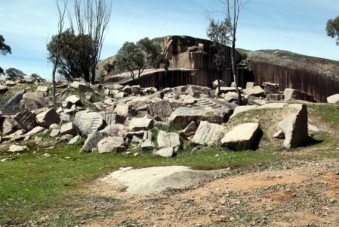
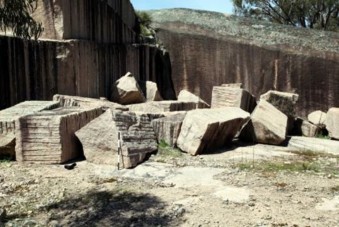
The geological characteristics of this rock are described in the Evans Crown Nature Reserve Plan of Management available at http://www.environment.nsw.gov.au/resources/parks/09140EvansCrown.pdf. This reserve lies on the Evans Crown Granite and Tarana Granite units of the middle to late Carboniferous Bathurst Batholith. The Evans Crown Granite is the youngest unit of the Bathurst Batholith and has been dated at 312 million years old. Evans Crown Granite underlies all but the north-western corner and a 200m wide strip along the eastern boundary of the reserve and comprises pink, medium to coarse grained, equigranular leucogranite, owing its colouration to a high proportion of K-feldspar.
Quartz, minor biotite and traces of plagioclase are also visible. The Evans Crown Granite intrudes the older Tarana Granite which underlies the remainder of the reserve and comprises (at this location) pink and grey coarse-grained biotite hornblende granite (Pogson and Watkins, 1998).
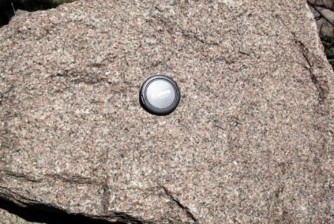
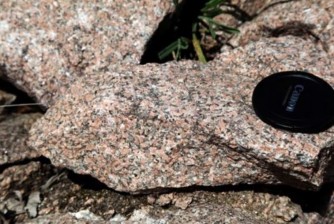
The economic significance of this rock derives from the use of Tarana granite as a monumental building stone in NSW. For many decades, Tarana granite was quarried and crushed from a quarry owned by NSW railways, adjacent to the main western railway near Tarana. It was used as the platform surface for all stations in NSW which did not have an asphalt seal. This original quarry is now worked out and abandoned and there are now no granite blocks of any size remaining.
The quarry location (Latitude S33˚34.98 Longitude E149˚52.26) is on the Tarana 1:25 000 topographic sheet, 8830-1-N. and is a few hundred metres from the nearest road (Carlwood Road) and is readily visible in Google Earth (below).
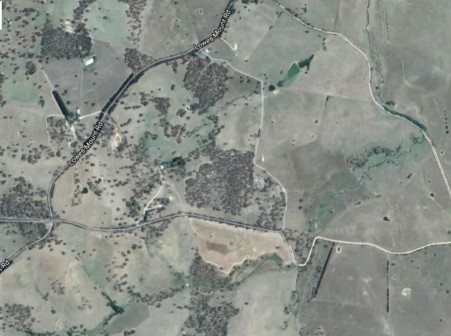
The access road to the quarry would need to be dry to enable access by heavy machinery.
The stratigraphic index reference is http://dbforms.ga.gov.au/pls/www/ geodx.strat_units.sch_full?- wher=stratno=17834. Tarana Granite is a strong durable rock with specimens located in a disused quarry – there are no transportation or preservation issues.
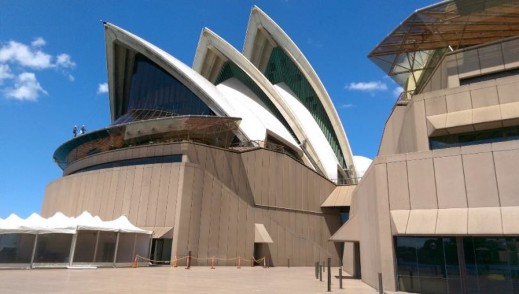
Image courtesy Mike Smith.
The cultural significance of the rock is reflected in its extensive use in the Sydney Opera House, which is characterised by the two coloured rocks used in the roof and the walls and floors. The roof of the Sydney Opera House is constructed of 1,056,000 glazed white granite tiles imported from Sweden (https://en.wikipedia.org/wiki/Sydney_Opera_House). Apart from the tile of the shells and the glass curtain walls of the foyer spaces, the exterior of the Opera House is largely clad with aggregate panels composed of pink granite quarried at Tarana in NSW.
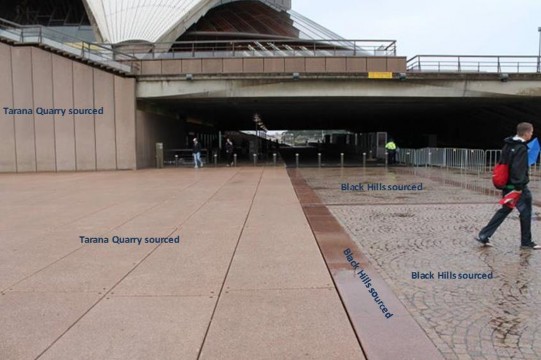
Two Australian rocks have been used in the courtyards, steps and vertical walls of the Sydney Opera House. These are Tarana Granite from the Bathurst area of NSW and Sienna granite from Black Hills in South Australia. When observing the Sydney Opera House from a distance, it is the pinkish red colour of the vertical panelling made using Tarana Granite which contrasts so brilliantly with the imported Swedish roof tiles.
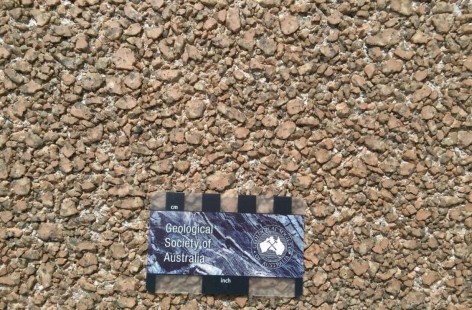
The exterior cladding of the ANZAC Memorial in Hyde Park, Sydney, is granite from Tarana. The stone reveals a range of dark browns, yellows and reds when polished. The quarry is now closed and the granite is reportedly no longer available for extraction.
A two-tonne block of pink Tarana Granite from a quarry near Orange in NSW was carved in situ at the northern side of the UNSW ANZAC Parade Gate during 1976 and 1977. The artist Anne Ferguson created Waterfall, kindly donating her time and skills. In Australia at this time, it was rare for women sculptors to work in stone. By keeping to University session times, Ferguson gave staff and students the opportunity to see an artist at work and to witness the emergence of Waterfall over 6 months. Carving vertical lines around the granite column she created places for rainwater to flow, in the same way ‘the wind and the rain carves grooves into the rocks in the bush’. The artist then presented the sculpture to the university. It was relocated in 1998, 2010 and 2012. (Text from UNSW Art Collection website: www.artcollection.unsw.edu.au/sculpturewalk.html).
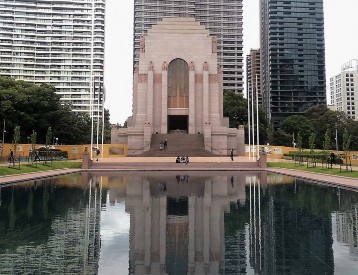
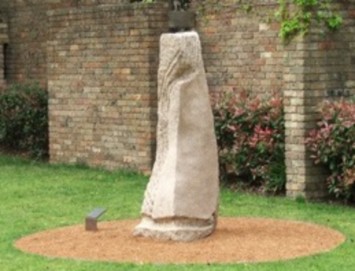
References
Chappell, B.W., English, P.M., King, P.L., White, A.J.R., Wyborn, D., 1991. Granites and related rocks of the Lachlan Fold Belt (1:1 250 000 scale map)., Bureau of Mineral Resources, Australia, 1v, map
Glen, R.A. , Walshe, J.L. 1999. Cross-structures in the Lachlan Orogen: the Lachlan Transverse Zone example, Australian Journal of Earth Sciences 46(4) p641–658. https://doi.org/10.1046/j.1440-0952.1999.00734.x
Pogson, D.J. and Watkins, J.J., 1998. Bathurst 1:250 000 Geological Sheet SI/55-8: Explanatory Notes, Geological Survey of New South Wales, Sydney
Ray, H.N., 1988. Dimension Stone in New South Wales. Geological Survey Report No. GS 1988/102, Geological Survey of NSW, Department of Mineral Resources, Sydney
Verard, C. and Glen, R.A., 2008. Magnetic fabrics of Paleozoic rocks across the Lachlan Transverse Zone from eastern New South Wales, Australian Journal of Earth Sciences 55(8) p1037–1048. https://doi.org/10.1080/08120090801982850


